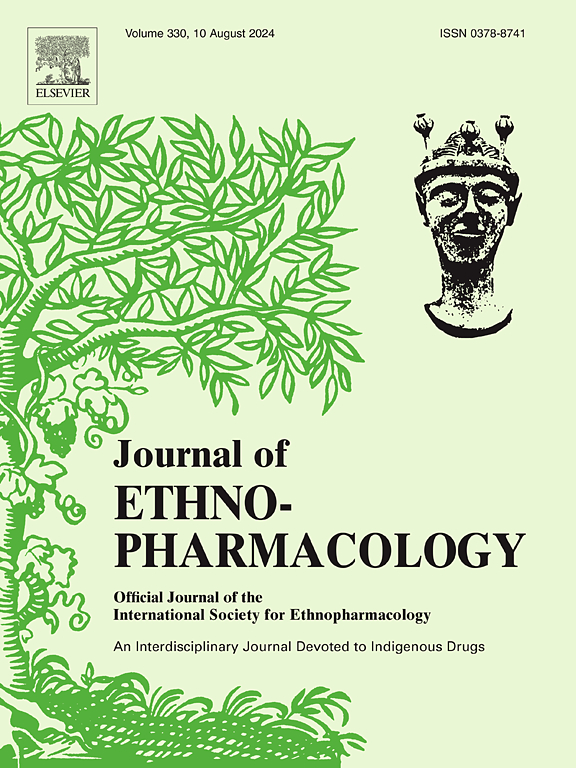Cornus officinalis loganin attenuates acute lung injury in mice via regulating the PI3K/AKT/NLRP3 axis
IF 4.8
2区 医学
Q1 CHEMISTRY, MEDICINAL
引用次数: 0
Abstract
Ethnopharmacological relevance
Cornus officinalis (CO), a pharmaceutical and food product, can reduce inflammation, alleviate oxidative stress and lower blood sugar levels. In particular, CO has been used to treat severe COVID-19 patients during the pandemic, revealing its protective effects against pneumonia.
Aim
In this study, the mitigating effects of CO ethanol extract (COEE) on acute lung injury (ALI) and the molecular mechanism were investigated and the main active components of COEE were screened.
Methods
The anti-inflammatory effects of CO on model animals assessed by evaluating the levels of proinflammatory factors and inflammasome components by H&E staining technique, ELISA, RT‒qPCR and immunofluorescence assays. Moreover, CCK8, LDH, and RT‒qPCR assays were also performed to assess the effect of CO on cell viability and its anti-inflammatory efficacy in vitro. The mRNA expression of inflammatory factors (IL-1β and TNF-α), and the protein expression of NLRP3 inflammasome members was evaluated. In addition, the molecular mechanisms and core pharmacodynamic components of CO were inferred by network pharmacology, and the relevant pathway targets were analyzed and verified by immunohistochemistry, Western blotting and RT‒qPCR. In vivo and in vitro models were also established to verify the effects of the main active ingredient Loganin (LOG) on ALI and the related molecular mechanisms.
Results
COEE significantly suppressed inflammation, mitigated lung tissue damage, and inhibited NLRP3 inflammasome activation in an LPS-induced murine ALI model and an inflammatory cell model. Network pharmacology screening and experimental data revealed that the PI3K/AKT signalling pathway is the direct target of CO, as COEE administration potently inhibited the activation of the PI3K/AKT/NLRP3 signalling pathway in vitro and in vivo, whereas the PI3K/AKT pathway agonist YS-49 apparently impaired the effects of COEE. Further studies revealed that LOG, a core ingredient in CO, mediated the effects of COEE via direct targeting of AKT1, and different doses of LOG had consistent and strong protective effects on ALI model mice.
Conclusion
COEE exerts therapeutic effects on LPS-induced ALI model mice by inhibiting the activation of the PI3K/AKT pathway and preventing the overactivation of the NLRP3 inflammasome, and LOG is the core medicinal substance. These findings also provide supporting evidence for the development of new nutraceuticals for the prevention and treatment of ALI.

山茱萸苷通过调节PI3K/AKT/NLRP3轴减轻小鼠急性肺损伤。
民族药理学相关性:山茱萸(CO)是一种药物和食品,可以减少炎症,缓解氧化应激和降低血糖水平。特别是在新冠肺炎大流行期间,一氧化碳被用于治疗重症患者,显示出对肺炎的保护作用。目的:研究CO乙醇提取物(COEE)对急性肺损伤(ALI)的缓解作用及其分子机制,筛选COEE的主要活性成分。方法:采用HE染色法、ELISA法、RT-qPCR法和免疫荧光法检测模型动物的促炎因子和炎性小体成分水平,评价CO对模型动物的抗炎作用。CCK8、LDH、RT-qPCR检测CO对细胞活力的影响及体外抗炎作用。检测炎症因子(IL-1β、TNF-α) mRNA表达及NLRP3炎性小体成员蛋白表达。此外,通过网络药理学推断CO的分子机制和核心药效学成分,并通过免疫组织化学、Western blotting和RT-qPCR对相关通路靶点进行分析和验证。建立了体内和体外模型,验证了主要活性成分马鞭草苷(login)对ALI的影响及其分子机制。结果:在lps诱导的小鼠ALI模型和炎症细胞模型中,COEE显著抑制炎症,减轻肺组织损伤,抑制NLRP3炎性体活化。网络药理学筛选和实验数据显示,PI3K/AKT信号通路是CO的直接靶点,COEE在体内外均能有效抑制PI3K/AKT/NLRP3信号通路的激活,而PI3K/AKT通路激动剂YS-49则明显削弱了COEE的作用。进一步研究发现,CO中的核心成分LOG通过直接靶向AKT1介导COEE的作用,不同剂量的LOG对ALI模型小鼠具有一致且强的保护作用。结论:COEE通过抑制PI3K/AKT通路的激活,防止NLRP3炎性体的过度激活,对lps诱导的ALI模型小鼠具有治疗作用,LOG为核心药效物质。这些发现也为开发预防和治疗急性呼吸道感染的新营养品提供了支持性证据。
本文章由计算机程序翻译,如有差异,请以英文原文为准。
求助全文
约1分钟内获得全文
求助全文
来源期刊

Journal of ethnopharmacology
医学-全科医学与补充医学
CiteScore
10.30
自引率
5.60%
发文量
967
审稿时长
77 days
期刊介绍:
The Journal of Ethnopharmacology is dedicated to the exchange of information and understandings about people''s use of plants, fungi, animals, microorganisms and minerals and their biological and pharmacological effects based on the principles established through international conventions. Early people confronted with illness and disease, discovered a wealth of useful therapeutic agents in the plant and animal kingdoms. The empirical knowledge of these medicinal substances and their toxic potential was passed on by oral tradition and sometimes recorded in herbals and other texts on materia medica. Many valuable drugs of today (e.g., atropine, ephedrine, tubocurarine, digoxin, reserpine) came into use through the study of indigenous remedies. Chemists continue to use plant-derived drugs (e.g., morphine, taxol, physostigmine, quinidine, emetine) as prototypes in their attempts to develop more effective and less toxic medicinals.
 求助内容:
求助内容: 应助结果提醒方式:
应助结果提醒方式:


